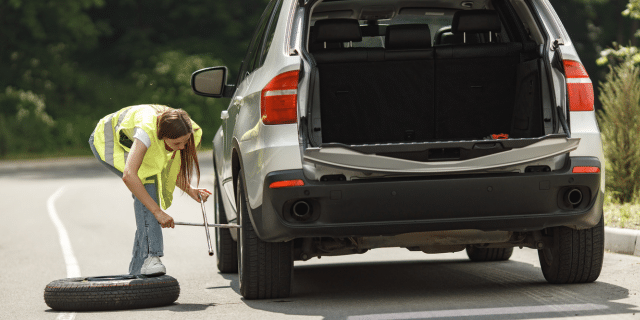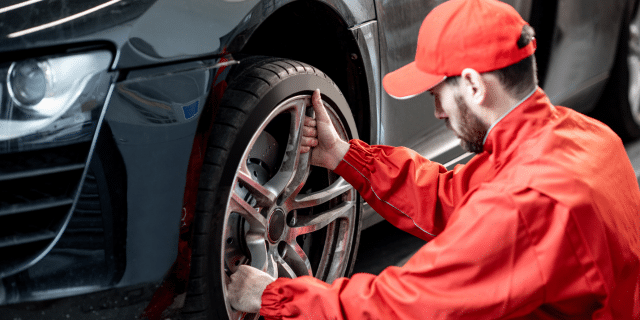
by California Casualty | Auto Insurance Info |
You take pride in your car’s appearance—shiny, clean, and polished to perfection. But even the most careful car owner can fall victim to everyday threats that silently sabotage that showroom sparkle. From spilled coffee to sunbaked bird droppings, the dangers are everywhere. Here’s what to watch out for—and how to fight back.
1. Parking Under Trees
Shady spots might seem like a great way to beat the heat, but trees come with risks. Sticky sap, falling branches and twigs, and even acorns can wreak havoc on your paint. Sap is especially stubborn—it bonds with the surface and can damage the finish over time. Use a bug and tar remover from your local auto store to gently lift it off.
2. Bird Droppings
Think of bird droppings as acid bombs for your paint job. They harden in the sun and can etch into your car’s finish if left too long. Wipe them off with a wet microfiber cloth using a gentle lifting motion (don’t scrub!). You can let the cleaner sit for a few minutes if needed to soften hardened spots.
3. Bug Splatter
Bugs on the windshield are just an annoyance. But bugs on your paint? That’s a problem. Many insects contain acidic compounds that can damage your finish. Clean them off ASAP with a dedicated bug remover or mild soap and water.
4. Fuel Spills
Fuel stains are more than ugly—they’re damaging. Gasoline can eat away at your paint and leave behind stubborn marks. Avoid topping off the tank to help prevent the chance of spills. If there’s a spill, clean it up immediately. Pro tip: Older brake fluid is also a known paint-stripper, so be extra careful when topping off your fluids.
5. Road Salt
Winter driving means road salt—and that means potential rust. Salt can corrode your car’s underbody and eat away at the paint if left unwashed. Rinse your car regularly in the winter and consider a protective wax coat before the first snowfall. Coastal drivers, take note: salty ocean air can do the same.
6. Writing in the Dust
We get it—drawing “Wash Me” on a dusty car is tempting. But those dust particles? They’re basically sandpaper. Dragging them across the surface can create micro-scratches. Dust mixed with rainwater can also become acidic, further damaging your finish. When you see dust, that’s a great time to run your vehicle through a car wash.
7. Dirty Sponges & Harsh Car Washes
Washing your car with a dirty sponge just grinds more grime into the paint. Stick to clean microfiber cloths, and avoid old-style brush car washes, which can leave swirl marks. Soft-cloth or touchless car washes are safer choices.
8. Coffee and Soda Spills
Placing your cup on the roof while fumbling for keys? We’ve all done it. But if you spill sugary or acidic drinks, they can stain your paint fast. Wipe off any spills immediately, especially soda and coffee.
9. Silly String & Shaving Cream Pranks
They might seem harmless, but Silly String contains resins and dyes that can bond to your paint, and shaving cream can leave behind lasting stains. If your car becomes the victim of a prank, rinse and wash it thoroughly as soon as possible.
10. Sprinkler Water Spots
Those white spots you see after a sprinkler hits your car? That’s mineral buildup from hard water, and over time, it can wear away your clear coat. Always dry your car with a microfiber towel—don’t let it drip dry.
Protect Your Paint Like a Pro
You can take steps year-round to protect your paint, and help it last longer.
- Park in a garage or covered area whenever possible.
- Wash your car regularly, especially after road trips or storms.
- Dry it completely with a microfiber towel to avoid water spots.
- Remove bird droppings, sap, and bugs as soon as you spot them.
- Wax your car every 3 to 6 months to maintain a protective barrier.
Your car is one of your biggest investments. Protect it with the right insurance for added peace of mind.
This article is furnished by California Casualty, providing auto and home insurance to educators, law enforcement officers, firefighters, and nurses. Get a quote at 1.866.704.8614 or www.calcas.com.

by California Casualty | Auto Insurance Info |
The freedom of summer is calling, and for many teens, that means hitting the road—often for the first time without a parent in the passenger seat. With new jobs, beach days, late-night hangouts, and spontaneous road trips on the agenda, it’s easy to forget that driving comes with serious responsibility. For parents, this season is a crucial time to set clear expectations behind the wheel. From curfews to passengers to phone use, establishing ground rules now can help your teen build smart habits that last far beyond the summer.
Follow intermediate licensing laws in your state.
Most states have graduated driver licensing (GDL) programs designed to help teens gain experience behind the wheel while minimizing risks. These often include rules like curfews, limits on passengers, and restrictions on highway driving. Start by familiarizing yourself with your state’s laws at www.ghsa.org. Then, build on those requirements with your own family rules. For instance, you might allow only daylight driving for the first month, then gradually expand driving privileges as your teen demonstrates responsibility.
Establish a nighttime curfew.
Driving at night is inherently more dangerous due to decreased visibility and increased likelihood of encountering impaired drivers. Teens, who are still developing experience and judgment, are especially vulnerable. Even if your state allows nighttime driving, consider setting a curfew that keeps your teen off the road during high-risk hours—often between 9 p.m. and 6 a.m. You might also require that they log a certain number of supervised nighttime hours with you before being allowed to drive alone after dark.
Ban cell phone use while driving.
Distracted driving is a leading cause of accidents, and teens are especially susceptible. While some states ban any cell phone use for drivers under 18, it’s smart to create a zero-tolerance rule at home regardless of local laws. That means no texting, no scrolling, and ideally, no hands-free calls unless absolutely necessary. Consider installing monitoring apps that block texts and calls while driving, and most importantly, model good behavior yourself—your teen is watching.
Talk about speeding—and how to avoid it.
Speeding contributes to nearly a third of all fatal teen crashes. Stress the importance of following posted speed limits, adjusting for weather conditions, and maintaining safe following distances. Teach your teen the three-second rule for following other vehicles, and how to give extra space to large trucks. Encourage them to build in extra time when leaving for work or social plans so they’re never tempted to rush.
Enforce seat belt use—every ride, every time.
Seat belts save lives, plain and simple. Make it a non-negotiable rule: the car doesn’t move until everyone is buckled up. Remind your teen that they are responsible for their passengers’ safety, too. Unbelted passengers can become deadly projectiles in a crash—even in the back seat.
Address impaired driving before it happens.
Teens may face peer pressure to drink or ride with someone who’s been drinking. It’s essential to talk openly about these situations and offer a safe exit plan. Let your teen know they can always call you for a ride—no questions asked—if they’re ever in an unsafe situation. Emphasize that driving under the influence of any substance, including marijuana or even some medications, is never acceptable.
Being a safe driver also means being prepared. Make sure your teen knows how to check the gas gauge and fill up when needed—ideally before it dips below a quarter tank. Show them how to recognize warning lights, check tire pressure, and know what to do in case of a breakdown. A quick review of the vehicle’s manual can go a long way in empowering your teen behind the wheel.
Know your teen’s driving plans.
As your teen begins driving independently, stay in the loop. Ask them to let you know where they’re going, who they’ll be with, and when they plan to return. If plans change, they should update you before getting behind the wheel again. Keeping control of the car keys is one way to ensure that you stay informed.
Put it in writing.
Consider drafting a parent-teen driving agreement that outlines the rules and consequences clearly. This written commitment can serve as a helpful reminder and a great conversation starter. It also opens the door for regular check-ins to reassess the rules as your teen gains experience. Be sure to revisit the agreement periodically, especially if any violations or concerns arise.
Don’t forget the insurance.
Before your teen starts driving, make sure they are properly insured. In some cases, good student discounts and safe driving programs can help lower costs. Most importantly, you want to be sure your teen is covered in the event of an accident.
Summer driving can be a rite of passage for teens—and a nerve-wracking time for parents. But with the right rules and a foundation of open communication, you can help your teen navigate this new freedom safely. Remember, driving is a privilege that comes with responsibility. By setting clear expectations and modeling safe behavior yourself, you’re laying the groundwork for a lifetime of smart driving choices.
This article is furnished by California Casualty, providing auto and home insurance to educators, law enforcement officers, firefighters, and nurses. Get a quote at 1.866.704.8614 or www.calcas.com.

by California Casualty | Auto Insurance Info |
Nothing throws a wrench in your day like the sudden thump-thump of a flat tire. But instead of panicking or waiting for roadside assistance, imagine confidently pulling over, grabbing your tools, and getting back on the road in no time. With a little know-how and a few easy steps, you can change a flat tire like a pro—and we’re here to show you how.
Step 1: Pull Over Somewhere Safe
At the first sign of a flat, slow down and carefully pull over to a safe location. Aim for a flat, firm surface away from traffic—never on grass, dirt, blind spots, or curves. If it’s nighttime, look for a well-lit area to work more safely. Turn off your engine, engage the parking brake, and switch on your hazard lights.
Step 2: Gather Your Tools and Supplies
You’ll need a few essentials to get the job done:
You might also find it helpful to have:
- Wheel wedges
- Tire pressure gauge
- Flathead screwdriver
- Portable tire inflator
- Flashlight (for nighttime)
- Gloves (to protect your hands)
Most of these tools can be found in a compartment under the rear cargo area—check your owner’s manual for specifics. It’s a good idea to keep these items, along with jumper cables and other emergency supplies, in your trunk or car storage.
Important: Some newer vehicles don’t come with spare tires. Instead, they may have run-flat tires or a spray sealant and inflator kit. In these cases, you will not be changing a tire. With run-flats, the tire’s reinforced sidewalls will allow you to drive for a short distance at a lower speed to a shop where you can get your tire replaced. If you have a spray sealant and inflator kit, follow those directions for the temporary tire repair, and again, drive to a place for a replacement.
Step 3: Loosen the Lug Nuts
Use the lug wrench to loosen the lug nuts (turn counterclockwise), but don’t remove them yet. Do this while the car is still firmly on the ground for better leverage. If they’re on tight, you may need to use your body weight. If your lug nuts are hidden behind hubcaps, use a flathead screwdriver to pop off or unscrew the hubcaps. Always check your manual if you’re unsure.
Note: If you have wheel locks, you will need to use your wheel lock “key” (adaptor) to loosen the specialized lug nuts.
Step 4: Position the Jack
Find your car’s designated jack points—typically near the wheels under the frame—and place the jack on the metal portion of the car. Jacking up in the wrong spot can damage your vehicle or cause it to become unstable. If you have them, this is the time to put wedges or chock blocks behind the wheels for added support. If you’re lifting the front of the car, put the block behind the back tire. For lifting the back of the car, put the block in front of the front tire. Choose the opposite corner of where you’re going to lift.
Once the jack is in place, slowly raise the car until the flat tire is about an inch or two off the ground. Never crawl under the vehicle while it’s supported only by a jack. (Need a refresher on jacking up a car? Check out our blog on how to use a jack!)
Step 5: Remove the Lug Nuts and the Flat Tire
Now that the car is elevated, remove the loosened lug nuts completely. Keep them safe—an upturned hubcap works perfectly as a container. Give the flat tire a firm pull to remove it from the wheel hub.
Step 6: Put on the Spare Tire
Line up the spare tire with the wheel studs. Make sure the valve stem (where you add air) is facing outward toward you. Place the lug nuts back on, tightening them by hand to hold the spare in place.
Step 7: Lower the Vehicle and Tighten the Lug Nuts
Carefully lower the vehicle back to the ground and remove the jack. Then, use the lug wrench to firmly tighten the lug nuts in a crisscross (star) pattern to ensure even pressure. Consult your manual if you’re unsure about the pattern.
Step 8: Check Your Tire Pressure
Use your tire gauge to check the spare’s pressure—and while you’re at it, check the other tires too. If needed, stop by a gas station for a quick top-off or use a portable air compressor if you have one handy. If you have nitrogen-filled tires, you’ll need to head to a shop that offers nitrogen.
Step 9: Pack Up Your Tools
Make sure you return all your tools and supplies to their proper storage locations, so you’ll be ready next time.
Step 10: Remember: The Spare Is Temporary
If you’re using a smaller “donut” spare, drive carefully. Stay under 50 mph and get your tire professionally replaced as soon as possible. Even if you have a full-sized spare, it’s still smart to replace it quickly and reset your vehicle’s emergency kit. It’s also a good idea to periodically check your spare’s condition and pressure. (You’ll find the recommended PSI in your owner’s manual).
How to Help Avoid a Flat Tire
While you can’t always prevent a flat, you can minimize your risk by following these tips:
- Inspect Your Tires Regularly: Check for signs of wear, punctures, and bulges.
- Maintain Correct Tire Pressure: Follow the recommended PSI found in your owner’s manual or inside the driver’s side door.
- Rotate Your Tires: Every 5,000 to 8,000 miles helps ensure even wear.
- Avoid Road Hazards: Steer clear of potholes, debris, and rough surfaces when possible.
- Don’t Overload Your Vehicle: Excess weight strains your tires and increases the risk of blowouts.
Finally, protect yourself and your vehicle with the right insurance for added peace of mind. Safe travels.
This article is furnished by California Casualty, providing auto and home insurance to educators, law enforcement officers, firefighters, and nurses. Get a quote at 1.866.704.8614 or www.calcas.com.

by California Casualty | Auto Insurance Info, Safety |
When the rest of the world is winding down, you’re just gearing up—saving lives, keeping streets safe, answering calls, and making sure others get the care they need. Whether you’re a nurse on the night shift, a paramedic racing the clock, or a police officer patrolling quiet streets, late-night and long-shift driving comes with its own set of challenges. Fatigue, low visibility, and unpredictable road conditions can all put you at risk. That’s why staying alert—and staying safe—behind the wheel is just as important as the job you’re heading to.
The Reality of Night Shift Driving
According to the National Highway Traffic Safety Administration (NHTSA), night shift workers are three times as likely to be involved in drowsy driving crashes. Most of these accidents occur between midnight and 6 a.m.—the time when your body naturally wants to sleep due to your circadian rhythm (your internal biological clock). That’s why it’s essential to have a safety plan in place before you start your engine.
Quick Fixes to Stay Alert After a Long Shift
Take a short nap before you leave.
Even 15 to 30 minutes can make a difference. A quick rest can reduce sleepiness and give you a safer start to your drive.
Why It Works: A power nap (15–30 minutes) allows your brain to enter the early stages of non-REM sleep, reducing sleep pressure and boosting alertness without entering deep sleep, which can cause grogginess. It restores neurotransmitter balance and improves reaction time—essential for a safe drive home.
Move before you cruise.
Before you get into the car, try stretching or walking briskly to activate your body and brain.
Why It Works: Physical activity increases blood flow and oxygen to the brain, boosting alertness by stimulating the release of norepinephrine and dopamine. Movement also raises core body temperature slightly, which can enhance wakefulness.
Skip the heavy meals and late caffeine.
Heavy meals can make you sluggish, and caffeine too close to bedtime can interfere with your post-shift rest. Save your sleep—and your stomach.
Why It Works: Heavy meals, especially those high in fats and carbs, divert blood flow to the digestive system, leading to a “food coma.” Meanwhile, caffeine has a half-life of about 5–7 hours, and late intake can block adenosine receptors, disrupting sleep cycles and impairing recovery.
Crunch it out.
Keep crunchy snacks like carrots, granola, or even ice handy as you drive. The chewing motion and texture engage your senses and help you stay alert.
Why It Works: The act of chewing stimulates the trigeminal nerve, increasing blood flow to the brain. Crunchy textures and repetitive motion provide sensory input that can help maintain alertness.
Phone a friend.
A conversation can stimulate your brain and help keep you focused. Bonus: it’s a great way to stay connected during off-hours.
Why It Works: Talking with someone activates multiple brain regions including the prefrontal cortex, responsible for attention and decision-making. This kind of mental activity keeps your brain busy in a good way—making it less likely to fall into microsleep.
Get moving at red lights.
Take advantage of stoplights to stretch, drum on the steering wheel, or do a little seated dance. Getting your blood flowing helps you stay awake.
Why It Works: Even small physical movements can activate your nervous system, raise your heart rate, and help you feel less tired. These brief bursts of activity can break up long periods of sitting and help prevent drowsiness while driving.
Let the fresh air in.
Roll down the window or blast the A/C. A blast of cold air to the face can help jolt you awake.
Why It Works: Breathing in cold air wakes up your body by stimulating a nerve in your face and the part of your brain that keeps you alert. It works like a small jolt, triggering your body’s alert system.
Belt it out.
Sing along to your favorite tunes. It’s almost impossible to drift off while belting out a chorus.
Why It Works: Singing engages multiple brain centers (auditory, motor, and emotional), keeping your brain stimulated. It also makes you breathe deeply, which brings in more oxygen and helps fight off tiredness.
Buddy up.
If possible, carpool with a co-worker. Not only can you take turns driving, but you can also help keep each other alert. Bonus: Carpooling helps reduce your mileage.
Why It Works: Social interaction, shared attention, and the presence of another person can all heighten alertness through increased stimulation of the brain’s executive functions. Alternating drivers can also prevent over-fatigue, reducing the risk of micro-sleeps or delayed reaction times.
Know the Signs of Drowsy Driving
Don’t ignore the warning signs of drowsy driving. If you experience any of these, it’s time to pull over:
- Frequent yawning
- Difficulty keeping your eyes open
- Nodding off
- Drifting from your lane
- Missing road signs or turns
- Inconsistent speed
- Trouble remembering the last few miles
If you’re too tired to drive, don’t push through. Pull over in a safe place and take a nap—even a short one can be lifesaving.
Planning for the Long Haul: Better Sleep for Safer Driving
While short-term tricks can help in the moment, long-term strategies are key for your well-being.
Set a consistent sleep schedule.
Even on your days off, try to stick to the same sleep-wake cycle. This helps train your internal clock and reduces grogginess.
Optimize your sleep environment.
Use blackout curtains, white noise machines, or eye masks to block out daylight and noise. Keep your room cool and tech-free.
Talk to your doctor if needed.
If you’re struggling to sleep despite your best efforts, you may have Shift Work Sleep Disorder (SWSD). A healthcare professional can help you manage it effectively.
You’re the one that others count on—make sure you’re taking care of yourself, too. A few smart habits can help you stay safe behind the wheel and make it home to rest, recharge, and get ready to do it all again.
This article is furnished by California Casualty, providing auto and home insurance to educators, law enforcement officers, firefighters, and nurses. Get a quote at 1.866.704.8614 or www.calcas.com

by California Casualty | Auto Insurance Info, Safety |
There’s nothing quite like prom and graduation season—the photos, the dresses and tuxes, the flowers, the celebrations. But while your teen may be focused on finding the perfect outfit or planning the after party, you’re likely thinking about something else entirely: their safety on the road.
Here are some tips to help your teen navigate prom, graduation, and all the celebrations in between—safely.
1. Make “leaving early” a habit.
Encourage your teen to leave at least 10 minutes earlier than needed—more if weather conditions are poor. This reduces the urge to speed and gives them time to react calmly to traffic or detours. If they’re heading to the same event as many others, they might also encounter fewer cars and pedestrians if they beat the rush.
2. Limit passengers.
It’s fun to pile into a car with friends, but the more people you have, the more distractions the driver encounters. Set limits on how many friends can ride with your teen and remind them that safety comes before socializing.
3. Always buckle up.
Seat belts are simple but lifesaving. Make sure your teen—and everyone in their car—buckles up before the engine starts. Reinforce the message that seat belts are non-negotiable, even for short trips.
4. Phones down, eyes up.
Phones are one of the biggest distractions for drivers, especially teens. Talk with your teen about putting their phone away while driving. There are apps that can silence notifications, send automatic replies, and even block texts while the car is in motion. Sharing their location with you is also a smart move in case you need to reach them in an emergency.
5. Minimize all distractions.
Texting isn’t the only distraction. Eating, drinking, adjusting the music, or checking makeup can all take attention off the road. Remind your teen to stay focused and wait until they’re parked to multitask.
6. Don’t drive while drowsy.
With finals, late-night celebrations, and packed schedules, your teen may not be getting enough sleep. Driving tired is just as dangerous as driving under the influence. If they feel themselves nodding off, they should pull over in a safe place and rest before continuing.
7. No drinking and driving—ever.
This one may seem obvious, but it bears repeating. Teens should never get behind the wheel after drinking or using any substance. Have an open conversation about peer pressure and agree on a “safe word” they can use if they need you to pick them up—no questions asked.
8. Keep an emergency kit in the car.
Whether it’s a flat tire, dead battery, or a minor fender bender, your teen should know what to do in case of a car emergency. Pack a basic kit with a flashlight, jumper cables, water, a first-aid kit, and emergency contact numbers. Make sure they know how to use everything in it. Teach your teen basic vehicle care and warning signs.
9. Be accident-ready, just in case.
Teens are often accident-prone because of their inexperience behind the wheel. Make sure your teen knows what to do if they’re ever in a crash. Go over the basics together: stay calm, check for injuries, move to safety, call 911, and exchange information with the other driver. Keeping an emergency kit in the car and insurance details in the glove box can also help them feel more prepared and confident.
10. Set a curfew.
More than 40% of fatal crashes involving young drivers happen between 9 p.m. and 6 a.m. It’s not just the challenge of driving in the dark—late-night trips are often social outings where distractions and peer pressure can run high. Even rule-following teens can be tempted to take risks. Setting an earlier curfew than your state requires can help keep your teen safer. Bonus: Offer to drive them and pick them up for late night outings.
11. Control the keys.
When teens have to ask for the car, it naturally opens the door for conversation. It’s a built-in pause that gives parents a moment to check in—about where they’re headed, who they’ll be with, and when they plan to return. It’s also a subtle reminder that driving is a privilege, not a right, and that responsibility comes with it. Keeping the keys in your hands helps reinforce expectations and encourages accountability.
12. Monitor risky behavior.
Consider a monitoring device or app that can track risky behaviors such as speeding, abrupt acceleration and sudden braking. You can also keep tabs on your teen’s location with GPS tracking. Some systems have a silent alarm so your teen can signal SOS if they feel unsafe.
Finally, this is a good time to review your insurance. Is your teen properly covered? Have you discussed all the ways you can save with a teen driver? Ensuring your policy is up to date can give both of you peace of mind during this high-risk season.
Prom and graduation are once-in-a-lifetime milestones, and you want your teen to enjoy them to the fullest—safely. Start the conversation early, model safe driving behavior yourself, and let them know you’re always just a phone call away. Your guidance and trust go a long way in helping them make smart decisions behind the wheel.
This article is furnished by California Casualty, providing auto and home insurance to educators, law enforcement officers, firefighters, and nurses. Get a quote at 1.866.704.8614 or www.calcas.com.

by California Casualty | Auto Insurance Info |
Imagine walking out to your car, only to find it sitting on cinder blocks—your wheels gone without a trace. Wheel theft is on the rise, and thieves are getting faster and bolder. Here’s how to protect your vehicle from becoming an easy target.
Why Are Wheels and Tires a Target for Thieves?
Wheels and tires are some of the easiest and most profitable car parts to steal.
- Quick and Easy to Remove: With a jack and an impact wrench, thieves can steal a full set of wheels in as little as 10 minutes.
- No Serial Numbers: Unlike other car parts, wheels and tires don’t have identifying numbers, making them nearly impossible to track.
- High Resale Value: Stolen wheels and tires can be sold quickly, often for hundreds or even thousands of dollars.
How to Prevent Wheel Theft
If your wheels are stolen, you’re looking at a hefty bill to replace them—not just for the wheels and tires, but also for any damage caused during the theft. The key to protecting your wheels is making your car a more difficult target. Here are some effective strategies.
1. Use Lug Nut Locks
Thieves must remove the lug nuts to access your wheel. Make that task impossible by replacing one lug nut on each wheel with a locking nut that requires a special key to remove. These are widely available at auto stores and provide an added layer of security. However, be sure to store the key in a safe place—you’ll need it when you change a tire.
2. Install a Tilt Sensor Alarm or Dash Cam
Consider a tilt sensor alarm that sounds off when it detects changes in the vehicle’s angle, such as when a thief attempts to jack it up. Similarly, you may want a dash cam with motion sensors to record any suspicious activity. When you purchase an aftermarket alarm, make sure it syncs with your car’s existing alarm system. You may need to take it to your mechanic to get it professionally installed so it will work on your vehicle.
3. Use Smart Parking Strategies
Where and how you park can make a big difference:
- Choose well-lit, high-traffic areas. Thieves prefer working in the shadows and avoiding locations with security cameras or frequent foot traffic.
- Park close to the curb. Positioning your car so that the wheels are near the curb makes it harder for thieves to use a jack.
- Turn your wheels. Angling your wheels at a 45-degree angle toward the curb makes it more difficult to access the lug nuts, as the inner fender will block them.
- Park in the garage. If you have access to a garage at home, park your vehicle inside so it is out of sight with no easy access for thieves.Cover Your Car
A vehicle cover can deter thieves by concealing your wheels and adding an extra step they may not want to take. While not foolproof, it’s another barrier that could make your car less attractive to criminals.
4. Use a Wheel Lock Boot
For added protection, especially if you’ll be leaving your car parked for an extended period, consider investing in a wheel lock boot. Like those used by parking enforcement, these devices prevent the wheels from turning. While they require time and effort to install, they are a significant deterrent to theft.
5. Start a Neighborhood Watch
Share contact information with your neighbors so you can communicate if something happens. Encourage them to keep an eye out on your street. Use your neighborhood text chain, Ring doorbells or apps like NextDoor to report suspicious activity.
If Your Wheels Are Stolen
Even with the best precautions, wheel theft can still happen. If you have been a victim, take these steps:
1. Call the Police and File a Report
Report the theft immediately. Provide details such as the make and model of your vehicle, where it was parked, and any security footage or eyewitness accounts. A police report is crucial for insurance claims and potential recovery.
2. Contact Your Insurance Company
If you have comprehensive coverage, your auto insurance may cover the cost of replacing stolen wheels. Provide the police report and any other requested documentation to initiate the claims process.
3. Check for Security Camera Footage
If you parked near a business, apartment complex, or home with security cameras, ask if they captured any footage of the theft. This can help law enforcement identify suspects and track down stolen wheels.
4. Arrange for Temporary Transportation and Repairs
Without wheels, your car may need a tow to a repair shop. Contact your insurance provider to see if they cover towing expenses and explore rental car options while your vehicle is being repaired.
5. Look for Your Stolen Wheels Online
Thieves often sell stolen wheels on online marketplaces like Craigslist, Facebook Marketplace, or local classified ads. If you spot wheels that match yours, notify the police instead of confronting the seller.
Wheel theft is a growing problem, but by taking proactive steps, you can greatly reduce your risk. Protect your car with the right insurance for added peace of mind.
This article is furnished by California Casualty, providing auto and home insurance to educators, law enforcement officers, firefighters, and nurses. Get a quote at 1.866.704.8614 or www.calcas.com.






